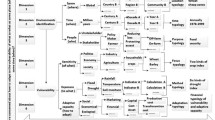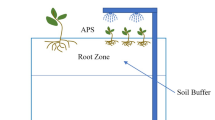Abstract
This paper presents a regionalized vulnerability curve-building approach to vulnerability and risk assessment of wheat subjected to drought that uses the Environmental Policy Integrated Climate (EPIC) model and statistical analysis. We defined wheat vulnerability as the degree to which a wheat production system is likely to experience yield loss due to a perturbation or drought hazard. Wheat vulnerability in a given region is thus the yield loss divided by the drought hazard index (DHI). By simulating a variety of wheat yield losses and associated DHIs, wheat drought vulnerability curves can be developed. We propose that agricultural systems be considered uniform within each wheat-planting region and different in different regions, according to territorial differentiation, when regionalized vulnerability curves are built. Based on this principle, a detailed regional crop calendar was improved, and optimized wheat varieties were refined that can differentiate agricultural systems within wheat-planting regions. The crop calendar was improved based on the assumption that local farmers have perfect knowledge in selecting sowing and harvesting dates. The wheat varieties were optimized by adjusting the genetic parameters of wheat in the EPIC model using the Shuffled Complex Evolution algorithm–University of Arizona (SCE-UA) method. Based on these improvements and innovations, the precision of most vulnerability curves was improved, and the curves were compared favorably to those observed in previous studies related to differences in the genetic character of wheat, the crop calendar, environmental conditions, and other relevant factors. Differences within each region were smaller than differences between regions. More detailed wheat vulnerability curves allow for the assessment of expected wheat yield loss and also allow for a high level of precision in an evaluation, at a variety of scales, of risk of wheat subject to drought. The proposed approach to building regionalized vulnerability curves has the potential to be the basis for crop drought vulnerability curves in different geographical areas at multiple scales.










Similar content being viewed by others
References
Angstrom A (1924) Solar and terrestrial radiation. Report to the international commission for solar research on actinometric investigations of solar and atmospheric radiation. Q J R Meteorol Soc 50(210):121–126
Birkmann J (ed) (2006) Measuring vulnerability to promote disaster-resilient societies: conceptual frameworks and definitions. In: Measuring vulnerability to natural hazards: towards disaster resilient societies. United Nations University Press, Tokyo, pp 9–54
Blaikie P, Cannon TD, Davis II, Wisner B (1994) At risk: natural hazards, people’s vulnerability and disasters. Routledge, London
Brooks N (2003) Vulnerability, risk and adaptation: a conceptual framework. Tyndall Cent Clim Change Res Work Pap 38:1–16
Cao Y, Yang J, Xiong W et al (2014) Simulation of winter wheat yield influenced by potential drought in China during 1962-2010. Trans Chin Soc Agric Eng 30(7):128–139 in Chinese
Chaney WR (1981) Sources of water. Water Deficits Plant Growth 6:1–47
Colombi M, Borzi B, Crowley H, Onida M, Meroni F, Pinho R (2008) Deriving vulnerability curves using Italian earthquake damage data. Bull Earthq Eng 6(3):485–504. doi:10.1007/s10518-008-9073-6
Cutter SL (1996) Vulnerability to environmental hazards. Prog Hum Geogr 20:529–539
Duan Q, Sorooshian S, Gupta V (1992) Effective and efficient global optimization for conceptual rainfall-runoff models. Water Resour Res 28(4):1015–1031
Duan Q, Gupta VK, Sorooshian S (1993) Shuffled complex evolution approach for effective and efficient global minimization. J Optim Theory Appl 76(3):501–521
Duan Q, Sorooshian S, Gupta VK (1994) Optimal use of the SCE-UA global optimization method for calibrating watershed models. J Hydrol 158(3):265–284
Dutta D, Herath S, Musiake K (2003) A mathematical model for flood loss estimation. J Hydrol 277(1–2):24–49. doi:10.1016/s0022-1694(03)00084-2
FAO (2011) http://faostat3.fao.org/search/wheat/E/. Download in 11-12-2014
Field CB, Barros V, Stocker TF, Dahe Q (2012) Managing the risks of extreme events and disasters to advance climate change adaptation: special report of the intergovernmental panel on climate change. Cambridge University Press, Cambridge
Gaiser T, de Barros I, Sereke F, Lange F-M (2010) Validation and reliability of the EPIC model to simulate maize production in small-holder farming systems in tropical sub-humid West Africa and semi-arid Brazil. Agric Ecosyst Environ 135(4):318–327. doi:10.1016/j.agee.2009.10.014
Ganji A, Ponnambalam K, Khalili D, Karamouz M (2006) Grain yield reliability analysis with crop water demand uncertainty. Stoch Environ Res Risk Assess 20(4):259–277. doi:10.1007/s00477-005-0020-7
He B, Lü A, Wu J, Zhao L, Liu M (2011) Drought hazard assessment and spatial characteristics analysis in China. J Geogr Sci 21(2):235–249
Hohl R, Schiesser H-H, Aller D (2002) Hailfall: the relationship between radar-derived hail kinetic energy and hail damage to buildings. Atmos Res 63(3):177–207
ISDR (United Nations International Strategy for Disaster Reduction) (2002) Living with risk. A global review of disaster reduction initiatives. ISDR, Geneva
Jia H (2010) Corn drought disaster risk assessment of China. Dissertation, Beijing normal university. in Chinese
Jia H, Wang J, Cao C, Pan D, Shi P (2012) Maize drought disaster risk assessment of China based on EPIC model. Int J Digit Earth 5(6):488–515
Jiang G, Yu F, Zhao Y (2012) An analysis of vulnerability to agricultural drought in China using the expand grey relation analysis method. Procedia Eng 28:670–676. doi:10.1016/j.proeng.2012.01.789
Kim DH, Yoo C, Kim T-W (2011) Application of spatial EOF and multivariate time series model for evaluating agricultural drought vulnerability in Korea. Adv Water Resour 34(3):340–350. doi:10.1016/j.advwatres.2010.12.010
Kim H, Park J, Yoo J, Kim T-W (2013) Assessment of drought hazard, vulnerability, and risk: a case study for administrative districts in South Korea. J Hydro-environ Res. doi:10.1016/j.jher.2013.07.003
Lee KH, Rosowsky DV (2005) Fragility assessment for roof sheathing failure in high wind regions. Eng Struct 27(6):857–868. doi:10.1016/j.engstruct.2004.12.017
Li J, Yue Y, Pan H, Ye X (2014) Variation rules of meteorological drought in China during 1961–2010 based on SPEI and intensity analysis. J Catastrophol 29(4):176–182 in Chinese
Liu J (2009) A GIS-based tool for modelling large-scale crop-water relations. Environ Model Softw 24(3):411–422. doi:10.1016/j.envsoft.2008.08.004
Liu J, Fritz S, van Wesenbeeck CFA, Fuchs M, You L, Obersteiner M, Yang H (2008) A spatially explicit assessment of current and future hotspots of hunger in Sub-Saharan Africa in the context of global change. Glob Planet Change 64(3–4):222–235. doi:10.1016/j.gloplacha.2008.09.007
McCarthy JJ (2001) Climate change 2001: impacts, adaptation, and vulnerability: contribution of Working group II to the third assessment report of the intergovernmental panel on climate change. Cambridge University Press, Cambridge
Merz B, Kreibich H, Thieken A, Schmidtke R (2004) Estimation uncertainty of direct monetary flood damage to buildings. Nat Hazards Earth Syst Sci 4(1):153–163
National Soil Survey Office (1994) Chinese soil genus records. China Agriculture Press, Beijing in Chinese
Prescott J (1940) Evaporation from a water surface in relation to solar radiation. Trans R Soc S Aust 64:114–118
Rinaldi Michele (2001) Application of EPIC model for irrigation scheduling of sunflower in Southern Italy. Agric Water Manag 49(3):185–196. doi:10.1016/S0378-3774(00)00148-7
Sharpley AN, Williams JR (1990) EPIC—erosion/productivity impact calculator. I. Model documentation. US Department of Agriculture Technical Bulletin No. 1768, 235 pp
Shi X, Yu D, Warner E, Pan X, Petersen G, Gong Z, Weindorf DC (2004) Soil database of 1:1,000,000 digital soil survey and reference system of the Chinese genetic soil classification system. Soil Surv Horiz 45:129–136
Sullivan CA (2011) Quantifying water vulnerability: a multi-dimensional approach. Stoch Environ Res Risk Assess 25(4):627–640. doi:10.1007/s00477-010-0426-8
Tobler WR (1970) A computer movie simulating urban growth in the Detroit region. Econ Geogr 46:234–240
Turner BL 2nd, Kasperson RE, Matson PA, McCarthy JJ, Corell RW, Christensen L, Eckley N, Kasperson JX, Luers A, Martello ML, Polsky C, Pulsipher A, Schiller A (2003a) A framework for vulnerability analysis in sustainability science. Proc Natl Acad Sci USA 100(14):8074–8079. doi:10.1073/pnas.1231335100
Turner BL 2nd, Matson PA, McCarthy JJ, Corell RW, Christensen L, Eckley N, Hovelsrud-Broda GK, Kasperson JX, Kasperson RE, Luers A, Martello ML, Mathiesen S, Naylor R, Polsky C, Pulsipher A, Schiller A, Selin H, Tyler N (2003b) Illustrating the coupled human-environment system for vulnerability analysis: three case studies. Proc Natl Acad Sci USA 100(14):8080–8085. doi:10.1073/pnas.1231334100
Wang C (2007) Research progress of major agricultural meteorological disasters. Chinese Meteorological Press, Beijing
Wang X, He X, Williams J, Izaurralde R, Atwood J (2005) Sensitivity and uncertainty analyses of crop yields and soil organic carbon simulated with EPIC. Trans Am Soc Agric Eng 48(3):1041
Wang Z, He F, Li J, Liao Y (2012) Assessment on drought risk of typical wheat in China based on EPIC model. Agric Res Arid Areas 30(5):210–215 in Chinese
Wang Z, He F, Fang W, Liao Y (2013) Assessment of physical vulnerability to agricultural drought in China. Nat Hazards 67(2):645–657. doi:10.1007/s11069-013-0594-1
Wilhelmi OV, Wilhite DA (2002) Assessing vulnerability to agricultural drought: a Nebraska case study. Nat Hazards 25(1):37–58
Williams JR (1995) The EPIC model. In: Singh VP (ed) Computer models of watershed hydrology. Water Resources Publications, Highlands Ranch, CO, pp 909–1000
Williams JR, Jones C, Dyke PT (1984) The EPIC model and its application. In: Proceedings of the ICRISAT-IBSNAT-SYSS symposium on minimum data sets for agrotechnology transfer, pp 111–121
Williams JR, Jones CA, Kiniry JR, Spanel DA (1989) The EPIC crop growth model. Trans ASAE 32(2):497–511
Wisner B (ed) (2004) At risk: natural hazards, people’s vulnerability and disasters. Psychology Press, London
Wu H, Wilhite DA (2004) An operational agricultural drought risk assessment model for Nebraska, USA. Nat Hazards 33(1):1–21
Wu J, Yu F, Chen Z, Chen J (2009) Global sensitivity analysis of growth simulation parameters of winter wheat based on EPIC model. Trans Chin Soc Agric Eng 25(7):136–142
Wu J, He B, Lü A, Zhou L, Liu M, Zhao L (2011) Quantitative assessment and spatial characteristics analysis of agricultural drought vulnerability in China. Nat Hazards 56(3):785–801. doi:10.1007/s11069-010-9591-9
Wu D, Yan D, Yang G, Wang X., Xiao W, Zhang H (2013) Assessment on agricultural drought vulnerability in the Yellow River basin based on a fuzzy clustering iterative model. Nat Hazards 67(2):919–936
Xu Y, Zhang X, Ran Q, Tian Y (2013) Impact of climate change on hydrology of upper reaches of Qiantang River Basin, East China. J Hydrol 483:51–60
Yin Y, Zhang X, Lin D, Yu H, Shi P (2014) GEPIC-VR model: a GIS-based tool for regional crop drought risk assessment. Agric Water Manag 144:107–119. doi:10.1016/j.agwat.2014.05.017
Yoo C, Kim S, Kim TW (2006) Assessment of drought vulnerability based on the soil moisture PDF. Stoch Environ Res Risk Assess 21(2):131–141. doi:10.1007/s00477-006-0050-9
Zhang Q, Xiao M, Singh VP, Chen X (2013a) Copula-based risk evaluation of hydrological droughts in the East River basin, China. Stoch Environ Res Risk Assess 27(6):1397–1406. doi:10.1007/s00477-012-0675-9
Zhang Z, Wang P, Chen Y et al (2013b) Spatio-temporal changes of agrometrorological disasters for wheat production across China since 1990. Acta Geogr Sin 68(11):1453–1460 in Chinese
Zhao G (2010a) Study on Chinese wheat planting regionalization (I). J Triticeae Crops 30(5):886–895 in Chinese
Zhao G (2010b) Study on Chinese wheat planting regionalization (II). J Triticeae Crops 30(6):1140–1147 in Chinese
Acknowledgments
This study was supported by the National Natural Science Foundation of China (No.41171402) and the National Key Basic Research Program of China (No. 2012CB955403). The Natural Science Research Program of Jiangsu (14KJA170001), the Priority Academic Program Development of Jiangsu Higher Education Institutions, Program of International S&T Cooperation, Ministry of Science and Technology of China (Project No. 2010DFB24140). The support received by A-Xing Zhu through the Vilas Associate Award, the Hammel Faculty Fellow, and the Manasse Chair Professorship from the University of Wisconsin–Madison and through the “One-Thousand Talents” Program of China is also greatly appreciated. The authors would like to thank the anonymous reviewers for their comments to improve the quality of this article.
Author information
Authors and Affiliations
Corresponding author
Rights and permissions
About this article
Cite this article
Yue, Y., Li, J., Ye, X. et al. An EPIC model-based vulnerability assessment of wheat subject to drought. Nat Hazards 78, 1629–1652 (2015). https://doi.org/10.1007/s11069-015-1793-8
Received:
Accepted:
Published:
Issue Date:
DOI: https://doi.org/10.1007/s11069-015-1793-8




